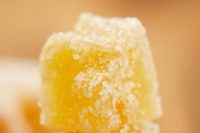Shaking It Up In Sugar-Free
By Paul Waldron, Gladson Interactive
Non-chocolate sales are coming on strong.
Retailers who feared that the sugar-free/diet candy category was shrinking away can rest assured that the business is merely shifting, not declining. In fact, non-chocolate sugar-free candy currently is one of the fastest-growing segments of the candy business. This is welcome news since sugar-free has been a segment delivering sweet gross margins and often incremental sales.
Statistics from ACNielsen for the 52-week period ended
September 9, 2006 (for food, drug and mass excluding Wal-Mart) show that
non-chocolate diet candy sales rose 6.7 percent to $97.2 million. In fact,
the non-chocolate portion of sales is catching up to sugar-free chocolate,
which is valued at $122.7 million and exhibited a decline of almost 30
percent for the tracked period.
Sugar-free products, when merchandised properly,
provide great opportunities to enhance the bottom line. The research firm
Euromonitor predicts sugar-free products will record a strong growth of
nearly 5 percent over the next five years. With non-chocolate sugar-free
making steady gains, retailers might want to examine diet candy planograms
to ensure merchandising reflects consumer demand.
There are many reasons, including the following, that
have contributed — and will continue to contribute — to the
success of the sugar-free product market.
Health concerns. Diabetes
currently affects 7 percent of the U.S. population, and about one-sixth of
the population (54 million people) has pre-diabetes. It’s not
surprising then that many food and drug retailers are actively engaged in
diabetes education.
But consumers’ sugar-free choices are not driven
only by diabetes or the fear of it. More Americans are watching their
health, especially as they age. Also, there is ongoing interest in reducing
the obesity rates of kids in America.
Improved products. Today
product formulators have an expanded array of sweetener options, which has
contributed to upgraded product taste profiles. Consumers have taste-tested
new sugar-free offerings and have come to recognize that being sugar-free
and tasting great are not mutually exclusive. Shoppers are more educated
about sweeteners, and branded sweeteners can influence purchase decisions.
More products. Now that
retailers and manufacturers know sugar-free is not a flash in the pan,
there are more items debuting bearing the label. An example of a product
with huge initial consumer acceptance in the sugar-free non-chocolate
segment is Sugar-Free Twizzlers. The next trend could be healthy additions
such as vitamins or antioxidants to diet candy.
House brands. Creative use
of sugar-free private labels is turning more shoppers into fans. With value
pricing, consumers aren’t afraid to try a product they may not be
sure will taste as good as the alternative. Retailers are creating
whimsical departments with clever signage and boutique-within-a-store
approaches.
Sugar-free gum.
There’s no denying sugar-free gum has helped draw attention to
non-chocolates. Sugar-free gum sales are rising in double-digit averages
from year to year.
Going for younger audience. Low-carb, no-sugar was first positioned to the diet conscious and
has been expanded to reach kids and teens. This dovetails with overall
efforts to reduce teen obesity as well as working with healthy school food
programs.
Seasonal options. Now that
manufacturers see diet candy is not a fad, more are creating seasonal
options such as sugar-free conversation hearts and limited editions.
Leading Vendors: Sugar-Free Non-Chocolate
Wm. Wrigley Jr. Co.
Private Label
Storck USA
Nestlé USA
The Hershey Company
Perfetti Van Melle
Simply Lite
Brach’s Confections
American Licorice Co.
Best Sweet Inc.
Note: For 52-week period ending Oct. 8, 2006
Source: Information Resources Inc.
Leading Vendors: Sugar-Free Chocolate
Russell Stover Candies Inc.
The Hershey Company
Whitman’s Chocolates*
Arkins Nutritionals
Nestlé USA
Simply Lite
Private Label
Ross Products
Fifty 50
Masterfoods USA
Note: For 52-week period ending Oct. 8, 2006
* Part of Russell Stover Candies, but broken out by
Information Resources Inc.
Source: Information Resources Inc.
Doing the Best by Sugar-Free Sweets
Give it a home. Research from the National
Confectioners Association shows that best-practice retailers establish a
sugar-free section within the regular candy department, rather than
positioning these products next to their brand counterparts. This approach
is based on the theory that most shoppers are looking to compare one
sugar-free product to another, rather than merely looking for the diet
equivalent of an existing favorite.
Beyond the fringe. Healthful candy is no longer a
fringe category. Thus it just doesn’t make sense to merchandise
sugar-free products only near the diabetes-care products, for example. For retailers
who haven’t already done it, now is the time to add sugar-free,
non-chocolates to the traditional mix as well.
Mix it up. The mix needs to be recalculated to
reflect the almost 50/50 nature of the business. Since diet non-chocolate
sales growth is faster than many other candy categories, it could be time
to add some more inches in the set for such products.
In the aisles. Although diet items need to be in
the traditional candy mix, they also lend themselves to secondary locations
and off-shelf presentations. The diabetes set is a natural, but retailers
might want to consider displays in cosmetics, the cereal aisle, weight
loss, oral care and at the checkout. Bagged programs can work very well for
the off-shelf presentations.



